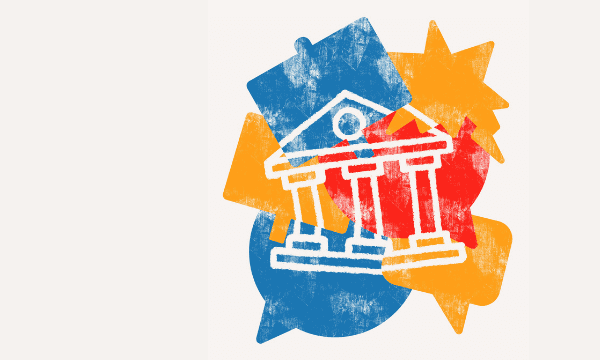
This essay is part of the “Debt Justice Agenda” series of Progressive International’s Debt Justice Blueprint.
Banks are the fulcrum in the machinery of global debt injustice. This year alone, private creditors such as HSBC are demanding $23 billion from debtor countries in Africa — three times the cost of vaccinating the entire continent against COVID-19. Unimpressed by moral appeals by bodies such as the G20, banks have simply refused to participate in debt relief for countries struggling to protect their populations amidst the pandemic. While this ruthless prioritization of bankers’ pockets over people’s lives is particularly shocking in a global health crisis, it is by no means exceptional.
Given the role of banks in the predatory debt agenda of global capitalism, it may be tempting to view them as inherently problematic institutions. Yet there is at least one good reason not to: the potential of public banks. In contrast to its corporatized private counterpart, public banking can harness finance for debt justice and the broader public good. Unlocking this transformative potential will require a bold progressive vision and equally bold socio-political strategies. This essay aims to contribute to both.
Taking Stock
Fortunately, one need not begin from scratch. Around the world today, there are more than 900 public banks with combined assets of $49 trillion — more than twice the size of the US economy. Not counting central and public multilateral banks, these include commercial/retail, national development, universal, and investment public banks in all shapes and sizes. Among the largest national public banks are the Industrial & Commercial Bank of China ($4.3 trillion in assets), the German KfW ($570 billion), the State Bank of India ($570 billion), and the Italian Cassa Depositi e Prestiti ($504 billion). But there are also small ones: the Uruguayan Banco Patagonia ($52 million) and the Uganda Development Bank ($100 million).
Public banks also have diverse historical legacies that shape their functions. Turkey’s Ziraat Bank was established in 1863 to fund agricultural development and later took on a role of national financial integration after 1924. The Bank of North Dakota, USA, was founded in 1919 by a local socialist party seeking to break the hold of powerful out-of-state bankers over small farmers. The German KfW came into being to channel incoming post-World War Marshall Plan funds into reconstruction. The Banco Popular y de Desarrollo Comunal, Costa Rica, was founded by the government in 1969 by and for the working class to combat usury. In early 2021, the United Kingdom Conservative Party founded a new National Infrastructure Bank to replace the functions performed by the European Investment Bank prior to Brexit.
Towards a Dynamic Theory of Public Banks
The aggregate economic evidence on public banking is inconclusive. Neoclassical theorists predictably argue that public banks are inherently inferior to more efficient private banks. Supporters of heterodox development theories, alternatively, often emphasize that public banks pursue social goals and fill market gaps.
Both approaches see ‘publicly-owned’ banks in starkly polarized terms, but public ownership is neither inherently good nor bad. Public ownership instead provides a sphere of potentiality, opening up the possibility of gearing public banks towards serving the public good. This implies a dynamic theory of public banks that sees social forces in racialized, gendered, and class-divided capitalist society shaping and re-shaping what it means for a bank to be ‘public’. It is a more realistic view of public banks, as it creates openings to reclaim banks for the public good and underscores the need to shield them from private interest capture. This is not merely a theoretical point. There is ‘no hope of a green and just transition without financial institutions that can be democratically commanded to function in the public interest.’
Seven Pillars of a Progressive People’s Bank
Merely stating this reality is however not enough. Given the huge societal and environmental toll of the power of undemocratic financial institutions, we must urgently lay out a progressive vision of what a people’s bank could look like. The following seven pillars illustrate the contours of a public bank geared towards the social and ecological good. These are not the only conceivable pillars and they are offered as part of a preliminary evidence-based progressive vision — a ‘realm of the possible’ if you will —, to spur debate and motivate action.
In my view, a progressive people’s bank must:
1. Be located within the public sphere:
Banks can be public in a variety of ways. This can be by formal public ownership by a government, public authority, or another public enterprise, through a cooperative or worker-owned structure, by meaningful public representation or control, by a legally binding public mandate or purpose, or by various combinations of these options. While being public alone guarantees nothing, it does provide a potential space for more progressive policies and practices to take shape. This is because through the public sphere a public bank can be shielded from the otherwise financialized competitive and profit-maximising imperatives characterising the contemporary world market.
2. Have clear public purpose and co-created missions:
For a public bank to move in a progressive direction, it needs clear public purpose and the capacity to tackle societal challenges according to co-created missions. Public purpose means having a legal democratic mandate to function by and for people and planet while reinforcing an operational ethos that connects bank workers and management to normative commitments to public service, public provisioning, and societal aspirations (not unlike a public utility). To help realise public purpose and to avoid capture by private interests, progressive public banks should tackle societal challenges by setting bold, clearly-defined, time-limited, measurable, and democratically co-created missions. For example, public banks whose purpose is to provide for green transitions and equitable living might help co-create a mission around financing a certain number of energy efficient social housing units by a given deadline by drawing together the actors needed and willing to achieve this goal, including governing authorities, community groups, public services, builders, and so on. By having co-created missions that fulfil the bank’s public purpose mandate and help overcome societal challenges, the bank will be less susceptible to capture by specific economic sectors (like oil and gas), by specific social classes (like finance capital), or by elites (like political, cultural, and bureaucratic ones) that might otherwise undermine said public purpose. Consequently, public banks build up societal credibility, armouring it against reactionary private financial interests looking to privatize it or subordinate it to their profiteering ends. Democratically mandated public purpose and co-created missions give direction to how the public bank interacts with all different types of actors, groups, and institutions, both public and private, nationally and internationally.
3. Be democratic:
There are many different ways in which public banks can be democratized and, to lesser and greater degrees, made accountable to society. There are representative models and other more direct and indirect means of political oversight and guidance. Precisely because they amass collective financial resources, build up institutional capacity and expertise, and channel vast amounts of finance through the public sphere into society, progressive public banks must be subject to structural, transparent, and accountable democratic oversight and direction that is representative of racialized, gendered, and class-divided communities. The forms can vary from place to place, but the principle of democratization needs to be fiercely upheld. This extends to the right of people to be able to choose to ‘bank’ publicly, rather than being limited only to private options.
4. Foster ecological society:
For a progressive public bank to be credible today, it must foster an ecologically sustainable society. This will involve setting clear and binding ecological floors for lending — below which the public bank will never agree to collaborate or do business. Examples of exclusion include the obvious, like highly carbonising energy projects, like oil, gas, and coal, and would likely extend to nuclear energy. Projects that endanger vulnerable plant, animal, and human communities as well as larger ecosystems would be excluded. And so on, as co-created and co-determined by the affected communities. Rather than supporting and subsidizing ecological destruction to the extent now done, this would leave public financial resources free to support ecological living. Commitment to this principle also brings knock-on benefits. Over time an ecological public bank can build up a legacy of institutional knowledge and financial firepower that can be bequeathed to other institutions as well as future generations, fostering intergenerational environmental justice and reparations.
5. Provide patient and definancialized funding:
There are many ways of sourcing capital and lending it out that can distance progressive public banks from the financialized short-term, profit-maximizing, and accumulation-oriented trajectories of private corporate banks and otherwise corporatized public banks. A key element is that public banks have sufficient public capital and political authority backing (including sovereign guarantees) to offer long-term and supportive patient finance directed toward achieving its mandate and missions. This is in opposition to conventional de-risking strategies of blending public money with private and, in doing so, bending public financing to the needs of private profit-oriented investors. Rather, progressive public banks should focus on harnessing flows of money to ‘fix’ them within their communities to achieve co-created missions. Applying the principle of free, prior, informed consent will help to slow and definancialize funding decisions (and democratize them). At the same time, providing patient finance may involve the provisioning of accessible retail banking services to all at socially acceptable terms. This may involve public banks being in direct competition with private banks (which is common worldwide), especially with predatory private banks that feed off of exploitative user fees and interest rates that drain families and communities of hope.
6. Anchor in public-public collaborations:
For strong and sustainable foundations for green and just transformation, progressive public banks need to be anchored to and building on public-public collaborations. This can take many forms. Public banks can be depository institutions for other public sector institutions and employees, whose savings can in turn support community projects. Public banks can work with anchor institutions, like hospitals, universities, municipalities, and government departments, to work out appropriate development planning and financing in ways that promote rather than erode and siphon off community wealth, knowledge, and well-being. At the same time, systems of public banks, public pension funds, wealth funds, and public investors can work together to channel their accumulated financial resources into socially legitimate and verifiable impact bonds issued by public banks that support ecological living, the environment, women, oceans, social housing, and even the Covid-19 recovery. This anchoring can provide stability and predictability, if fashioned democratically, accountably, and transparently.
7. Be financially sustainable:
There are many ways for public banks to be financially sustainable that do not imply profit-maximization. But financially sustainable they must be. Too much public and political capital and collective will goes into forging and maintaining a public bank for it to be driven into the ground by poor management, unrealisable expectations, or direct political abuse. It is vital that progressive public banks have means to economically reproduce themselves over time. Where operations involve bank losses, strategies for cross-subsidization or prior government support need to be in place. Where returns are generated, transparent rules need to direct surpluses to reserves or to define the conditions by which public shareholders receive payouts. There is no one right model, so long as it is viable and sustainable within the society in which the public bank must reproduce itself.
Public Banking and Global Transformation
As elaborated elsewhere, these pillars can be largely undertaken around a legally mandated triple bottom line that directs public banks at (1) a green and just transition; (2) financial sustainability; (3) and democratic decision-making. Taken together, the seven pillars and this triple bottom line would dramatically increase and positively transform the place of public banking in our global economy. Indeed, public banking can and should become a key driver of a global reorientation of socio-economic relations away from private greed, towards the public good. It is crucial to appreciate that this is not some far-fetched scenario, a utopian thought experiment. On the contrary, the features and functions discussed in this essay are drawn from the dozens of public banks that already exist today in virtually every continent. Of course, none of these are perfect — no public bank will ever be, certainly not as long as they operate in the shadow of global capitalism. This is why throwing a light on the potential of public banking and further developing a positive vision of its potential contribution towards global economic transformation is so important. Progressive people’s banks are within reach — collaboratively, we just have to design their blueprint. And with this blueprint at hand, progressive social forces locally, nationally, and globally can soon start reclaiming them and building them anew.
Thomas Marois is a member of the Progressive International Debt Justice Collective. Thomas Marois is Senior Research Fellow in Patient Finance and Public Banking at the UCL Institute for Innovation & Public Purpose (IIPP).
Illustration by Namita Sunil. Namita is a New Delhi based illustrator and graphic artist.
From the Blueprint team at Progressive International
We live in a world of debt. The depth and breadth of global “debtification” is difficult to overstate. It is the primary contention of this collection that all these disparate dynamics — hedge funds raking in pandemic profits, students struggling to afford an education, micro-borrowers on the brink of bankruptcy — are different manifestations of the same basic structural mechanism at the heart of the global financial system: the endless cycle of privatized gains and socialized losses. Simply put, the rich get richer, while the poor, by design, remain poor.
The goal of this Collective is the goal of progressive movements around the world, to end that cycle. Read the full Debt Justice Blueprint here. If you’re interested in engaging with us, please write to the Varsha Gandikota-Nellutla, Blueprint Coordinator at [email protected].



